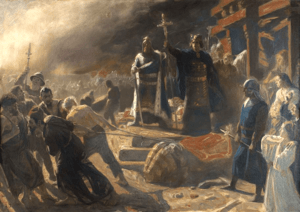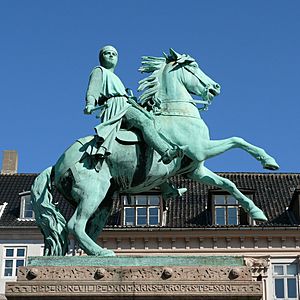Absalon facts for kids
Quick facts for kids Absalon |
|
|---|---|
|
|

Absalon's grave effigy
|
|
| Diocese |
|
| Predecessor |
|
| Successor |
|
| Personal details | |
| Born | c. 1128 near Sorø |
| Died | 21 March 1201 (aged 72–73) Sorø |
| Buried | Sorø Abbey |
Absalon (around 1128 – 21 March 1201) was an important Danish leader and church official. He served as the bishop of Roskilde from 1158 to 1192. Later, he became the archbishop of Lund from 1178 until his death. Absalon was the most powerful politician and church leader in Denmark during the second half of the 1100s. He was also the closest advisor to King Valdemar I of Denmark.
Absalon played a big part in Denmark's plan to expand its lands around the Baltic Sea. He also helped bring Denmark closer to the Catholic Church (called the Holy See). He worked to improve the relationship between the Church and the public. Absalon came from the powerful Hvide family and owned a lot of land. He gave money and land to several church groups, especially his family's Sorø Abbey. The king also gave him land, where he built the first fort for the city that later became modern-day Copenhagen. After he died, his important titles went to his nephews, Anders Sunesen and Peder Sunesen. He passed away in 1201 and was buried at Sorø Abbey.
Contents
Absalon's Early Life and Studies
Absalon was born around 1128 near Sorø on Zealand, a Danish island. His name was unusual in Denmark, so some think he was named on the Danish "Absalon" name day, October 30. His father, Asser Rig, was a powerful noble from the Hvide family. His mother was Inger Eriksdotter. He was also related to Archbishop Eskil of Lund.
Absalon grew up at his father's castle. He was raised with his older brother, Esbern Snare, and a young prince named Valdemar. This prince later became King Valdemar I of Denmark. While Denmark was in a civil war, Absalon went to Paris to study theology, which is the study of religious faith. In Paris, he learned about the idea that the Church should be independent from kings. He also became friends with a church leader named William of Æbelholt. Absalon later made William the abbot (head) of Eskilsø Abbey.
Absalon first appears in a history book called Gesta Danorum, written by Saxo Grammaticus. This was when the civil war ended. Absalon helped make a peace agreement between two rival kings, Sweyn III and Valdemar. Absalon and Valdemar barely escaped when Sweyn tried to kill them at a party in 1157. They fled to Jutland, where Sweyn followed them. Absalon likely wasn't in the battle where Sweyn was defeated and killed. This battle led to Valdemar becoming the King of Denmark. In 1158, Absalon was chosen to be the bishop of Roskilde on Zealand. King Valdemar helped him get this position as a reward for his family's support.
Absalon: Bishop and King's Advisor
Absalon became a very close advisor to King Valdemar. He was a strong supporter of Denmark's military campaigns against the Wends. During Denmark's civil war, the Wends, who were pirates living along the southern Baltic Sea, often attacked Danish coasts. Absalon wanted to get rid of these pirates. When Valdemar became king, a third of Denmark was ruined because of these raids.
Absalon created a special fleet to protect the coast. He also built defenses along the shore and led many attacks against the Wends. He even suggested forgiving Valdemar's past enemies, which helped bring peace inside Denmark.
Absalon's Campaigns Against the Wends
Absalon led his first expedition against the Wends in 1160. These early attacks were successful but didn't lead to lasting victories. What started as revenge attacks soon turned into full-scale campaigns to expand Danish lands and spread Christianity. For the next twenty years, Denmark fought crusades against the Wends. Sometimes, they had help from German Duke Henry the Lion.
In 1168, the main Wendish fort at Arkona on Rügen island was captured. This fort held the temple of their god, Svantevit. The Wends agreed to accept Danish rule and the Christian religion. From Arkona, Absalon sailed to Charenza, another strong fort in Rügen. The fall of Arkona had scared the people there, so they surrendered quickly. Absalon, with only a few men, went into the fort. He ordered the large statue of their god, Rugievit, to be chopped down and burned. Then, everyone in the area was baptized. Absalon also started building twelve churches on Rügen. Rügen then came under Absalon's Bishopric of Roskilde.
After destroying this main pirate base, Absalon could make the Danish fleet smaller. But he still watched over the Baltic Sea. In 1170, he destroyed another pirate stronghold further east. Absalon's last military success was in 1184. He soundly defeated a Pomeranian fleet that had attacked Jaromar of Rügen, who was a Danish ally.
Absalon's Political Goals
Absalon's main political goal was to make Denmark free from the influence of the Holy Roman Empire. He changed the Danish church to be more like the Catholic Church (Holy See). He wanted Denmark to be a close friend of the Holy See. However, during a disagreement between two popes, Absalon stayed loyal to King Valdemar. This was even when Valdemar supported the Holy Roman Emperor Frederick Barbarossa. This caused some division within the Danish church.
Absalon built churches and monasteries. He supported international religious groups like the Cistercians and Augustinians. He also started schools and worked hard to spread education and culture. In 1162, Absalon changed his family's Sorø Abbey from one religious order to another. He gave it land from his own property. In 1167, Absalon was given land around a town called Havn (meaning "Harbour"). He built a castle there to defend the coast from the Wends. Havn quickly grew into an important trading center. It eventually became modern-day Copenhagen.
Absalon also held the first Danish church meeting (called a Synod) in Lund in 1167. He was very interested in history and culture. He asked Saxo Grammaticus to write Gesta Danorum, a detailed history of the Danes. In 1171, Absalon created the "Zealand church law." This law reduced the number of church fines for people. It also started a system where people paid a tithe, which was a part of their income, to the church.
Absalon Becomes Archbishop of Lund
Archbishop Eskil returned from his travels in 1167. Eskil agreed to make Valdemar's father, Knud Lavard, a saint in 1170. Absalon helped him with this important event. When Eskil decided to step down as Archbishop of Lund in 1177, he chose Absalon as his replacement. Absalon didn't want the new job at first because he didn't want to lose his power in Zealand. But he followed the Pope's orders in 1178. The Pope made a special rule that allowed Absalon to keep his job as Bishop of Roskilde at the same time.
As the Archbishop of Lund, Absalon was a strong and effective leader. He made sure that all church practices followed the Pope's rules. A rebellion by farmers in Scania forced him to flee to Zealand in 1180. But he returned and put down the rebellion with King Valdemar's help.
King Valdemar died in 1182. His son, Canute VI, became king. Absalon continued to serve as a trusted advisor to Canute VI. Under Canute VI, Absalon was the main person guiding Danish politics. He kept his strong dislike for the Holy Roman Empire. When Canute VI became king in 1182, an ambassador from the Holy Roman Empire came to Denmark. He wanted the new king to promise loyalty to Frederick Barbarossa. But Absalon firmly refused this demand.
Absalon's Later Years and Death
Absalon stopped his military service in 1184 when he was 57 years old. He let younger leaders, like Duke Valdemar (who later became King Valdemar II), take charge of the armies and fleets. Instead, Absalon focused on managing the Danish lands. In 1192, Absalon made his nephew, Peder Sunesen, his replacement as Bishop of Roskilde. His other nephew, Anders Sunesen, became King Canute VI's chancellor (a high-ranking official).
Absalon died at Sorø Abbey on March 21, 1201, at 73 years old. In his last will, he gave his personal lands to the Abbey. However, he gave the land of Fjenneslev to his brother, Esbern Snarre. He had already given Copenhagen to the Bishopric of Roskilde. Absalon was buried at Sorø Abbey. His nephew, Anders Sunesen, became the new Archbishop of Lund.
Absalon's Lasting Impact
Saxo Grammaticus' book Gesta Danorum was finished after Absalon's death. Absalon was one of the main heroes in this book. It became the most important source of information about early Danish history. Absalon is remembered as the most important politician and church leader in Denmark during the 1100s. He was great as a churchman, a statesman (political leader), and a warrior. His plan to expand Denmark's lands gave Denmark control of the Baltic Sea for three generations.
Absalon clearly enjoyed fighting. But he was not like other fighting bishops of the Middle Ages. Those bishops sometimes used a mace instead of a sword in battle to avoid "shedding blood." Absalon always made sure to do his church duties too.
In the 2000s, the name "Absalon" was given to a class of ships in the Royal Danish Navy. The first ship in this class was named HDMS Absalon (L16). Another ship was named Esbern Snare (L17). These ships were launched by Denmark in 2004 and 2005.
See also
 In Spanish: Absalón de Lund para niños
In Spanish: Absalón de Lund para niños



